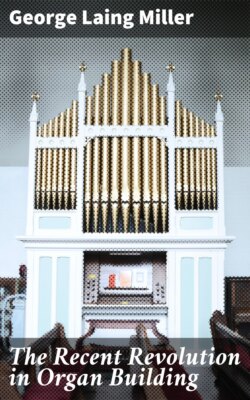Читать книгу The Recent Revolution in Organ Building - George Laing Miller - Страница 7
На сайте Литреса книга снята с продажи.
AS IT WAS IN THE BEGINNING.
ОглавлениеTable of Contents
"The Organ breathes its deep-voiced solemn notes,
The people join and sing, in pious hymns
And psalms devout; harmoniously attun'd,
The Choral voices blend; the long-drawn aisles
At every close the ling'ring strains prolong:
And now, of varied tubes and reedy pipes,
The skilful hand a soften'd stop controuls:
In sweetest harmony the dulcet strains steal forth,
Now swelling high, and now subdued; afar they float
In lengthened whispers melting into cadenced murmurs,
Forming soft melodious strains, and placid airs,
Spreading gently all around, then soaring up to Heav'n!"
—Dryden.
The origin of the pipe organ is lost in the mists of antiquity. Tradition hath it that there was one in Solomon's Temple at Jerusalem, the sound of which could be heard at the Mount of Olives. It has the honor of being the first wind instrument mentioned in the Bible (Genesis iv, 21), where we are told that "Jubal is the father of all such as handle the harp and the organ." The Hebrew word here is ugab, which is sometimes translated in the Septuagint by cithara (the ancient lute), sometimes by psalm, sometimes by organ. Sir John Stainer ("Dictionary of Musical Terms," p. 444) says: "It is probable that in its earliest form the ugab was nothing more than a Pan's-pipes or syrinx, but that it gradually developed into a more important instrument." The passage, however, shows that the ugab was known in the time of Moses, who was "learned in all the learning of the Egyptians."
The flute, a component part of the organ, is one of the most ancient of musical instruments. We find it pictured on the walls of early Egyptian tombs, and specimens of it, still in playable condition, have been unearthed and can be seen in our museums. Some of them were double, as shown in the illustration. Side by side with these flutes we find the shepherd's pipe with a reed or strip of cane in the mouthpiece, which may be found in the Tyrol at the present day. The next step was probably the bagpipes. Here we find four of these pipes attached to a bag. The melody or tune is played on one of the pipes furnished with holes for the purpose, while the other three give a drone, bass. The bag, being blown up, forms a wind reservoir and the amount of tone can be regulated by the pressure of the arm. Here we have the precursor of the organ bellows. Next comes the Irish bagpipes, with a bellows worked by the arm furnishing the wind to the bag, the reservoir, and producing a much sweeter tone. This is one line of advance.
